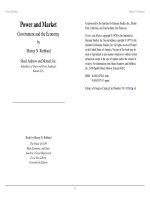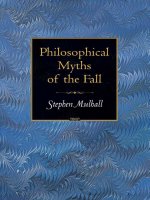princeton university press renormalization and 3-manifolds which fiber over the circle jul 1996
Bạn đang xem bản rút gọn của tài liệu. Xem và tải ngay bản đầy đủ của tài liệu tại đây (8.33 MB, 253 trang )
Renormalization
and
3-Manifolds
which
Fiber
over
the
Circle
by
Curtis
T.
McMullen
PRINCETON UNIVERSITY
PRESS
PRINCETON,
NEW
JERSEY
1996
Copyright © 1996 by PrincetonUniversity Press
ALL RIGHTS RESERVED
The Annals ofMathematics Studies
are
edited by
Luis
A.
Caffarelli,
John
N.
Mather,
and
Elias
M.
Stein
Princeton University Press books
are
printed on acid-free
paper
and
meet
the
guidelines for permanence
and
durability of
the
Committee on Production
Guidelines for Book Longevity
of
the
Council on Library Resources
Printed
in
the
United
States
ofAmerica by Princeton Academic Press
10 9 8 7 6 5 4 3 2 1
Library
of
Congress Cataloging-in-Publication
Data
McMullen, Curtis
T.
Renormalization
and
3-manifolds which fiber over
the
circle / by
Curtis
T.
McMullen.
p. cm. - (Annals ofmathematics
studies:
142)
Includes bibliographical references and index.
ISBN 0-691-01154-0 (cl : alk. paper). - ISBN 0-691-01153-2 (pb : alk. paper)
1.
Three-manifolds (Topology)
2.
Differentiable dynamical systems.
I. Title. II. Series: Annals ofmathematics
studies:
no. 142.
QA613. M42 1996
514'.3-dc20
96-19081
The publisher would like to acknowledge
the
author
of
this
volume for
providing
the
camera-ready copy from which
this
book was printed
Structures
on
surfaces
and
3-manifolds
Quasifuchsian groups . . . . . . . . . .
The
mapping class group .
Hyperbolic structures on mapping tori
Asymptotic geometry
Speed of algebraic convergence .
Example: torus bundles
Contents
1
Introduction
2
Rigidity
of
hyperbolic
manifolds
2.1
The
Hausdorff topology
2.2 Manifolds
and
geometric limits
2.3
Rigidity . . . . . . . . . . . . .
2.4 Geometric inflexibility . . . . . .
2.5 Deep points
and
differentiability
2.6 Shallow sets . . . . . . . . . . . .
3
Three-manifolds
which
fiber
over
the
circle
3.1
3.2
3.3
3.4
3.5
3.6
3.7
4
Quadratic
maps
and
renormalization
4.1 Topologies
on
domains . . . . . . . . . . .
4.2 Polynomials
and
polynomial-like maps
4.3
The
inner class .
4.4 Improving polynomial-like maps
4.5 Fixed points of quadratic maps
4.6 Renormalization
4.7 Simple
renormalization.
. . .
4.8 Infinite renormalization . . . . .
5
Towers
5.1 Definition
and
basic properties
5.2 Infinitely renormalizable towers
5.3
BOllIH)pd
(,()luhinatorics
5.4 rtohIlHf.IU'HH
and
illlH'r
rip;idity
1
11
· . .
11
12
17
24
32
34
41
42
44
46
50
53
60
65
75
75
·
76
78
83
86
88
91
92
95
·
95
97
99
.
101
vi
5.5 Unbranched renormalizations
6
Rigidity
of
towers
6.1 Fine towers
6.2
Expansion
6.3 Julia sets fill
the
plane
6.4 Proof of rigidity
6.5 A tower is determined by its inner classes
CONTENTS
· 103
105
· 106
.
108
112
· . 114
· . 117
7
Fixed
points
of
renormalization
119
7.1
Framework for
the
construction of fixed points
119
7.2 Convergence of renormalization . . . . . . . . . . . . . 127
7.3 Analytic continuation of
the
fixed point
128
7.4 Real quadratic
mappings.
. . . . . . . . . 132
8
Asymptotic
structure
in
the
Julia
set
8.1 Rigidity
and
the
postcritical Cantor set
8.2 Deep points of Julia sets .
8.3 Small Julia sets everywhere
8.4 Generalized towers
9
Geometric
limits
in
dynamics
9.1 Holomorphic relations
9.2 Nonlinearity
and
rigidity.
. . .
9.3 Uniform twisting .
9.4 Quadratic maps
and
universality
9.5 Speed of convergence of renormalization
10
Conclusion
Appendix
A.
Quasiconformal
maps
and
flows
A.l
Conformal structures on vector spaces
A.2 Maps
and
vector fields .
A.3 BMO
and
Zygmund class . . . . . . . .
A.4 Compactness
and
modulus of continuity
A.5 Unique integrability .
135
· . 135
· 139
· 143
· . 149
151
·
151
· 158
· 164
· 167
· 170
175
183
· . 183
· . 186
191
196
. 200
CONTENTS
vii
205
.
.205
· 217
·
221
. 226
·
232
.234
.
.237
Appendix
B.
Visual
extension
B.l
Naturality, continuity
and
quasiconformality
B.2 Representation theory .
B.3
The
visual distortion . . . . . . . . . .
B.4 Extending quasiconformal isotopies
B.5 Almost isometries .
B.6 Points of differentiability. . . . .
B.7 Example: stretching a geodesic.
Bibliography
241
Index
251
Renormalization
and
3-Manifolds which
Fiber over
the
Circle
1
Introduction
In
the
late 1970s
Thurston
constructed hyperbolic metrics on
Inost 3-manifolds which fiber over
the
circle. Around
the
same time,
Feigenbaum discovered universal properties of period doubling,
and
offered
an
explanation in
terms
of renormalization. Recently Sulli-
van established
the
convergence
of
renormalization for real
quadratic
Inappings.
In
this
work
we
present a parallel approach
to
renormalization
and
to
the
geometrization of 3-manifolds which fiber over
the
cir-
cle.
This
analogy extends
the
dictionary between rational maps
and
Kleinian groups; some of
the
new entries
are
included
in
Table 1.1.
Dictionary
Kleinian group f
~
1Tl (8)
Quadratic-like
map
f : U
+
V
Limit
set
A(f)
Julia
set
J(f)
Bers slice
By
Mandelbrot set M
Mapping class
1/J
: 8
~
S
Kneading
permutation
'l/J
:
AH(S)
+
AH(S)
Renormalization
operator
R
p
Cusps in
8By
Parabolic bifurcations in M
Totally degenerate
Infinitely renormalizable
group
r
polynomial f (z) =
z2
+c
Ending lamination
Tuning invariant
Fixed
point
of
'ljJ
Fixed point of
Rp
Hyperbolic
structure
on
Solution
to
Cvitanovic-Feigenbaum
M3
+
8
1
equation fP(z) = a I f(a.z)
Table 1.1.
Both
discussions revolve around
the
construction of a nonlinear
dynamical
SystClll
which
is
conformally self-similar.
2
CHAPTER
1.
INTRODUCTION
For 3-manifolds
the
dynamical system is a surface group acting
conformally on
the
sphere via a representation
p :
1t"l(S)
~
Aut(C).
Given a homeomorphism
'l/J
: S
~
S,
we
seek a discrete faithful
representation satisfying
for some
a E
Aut(C).
Such a p is a fixed point for
the
action of
1/1
on
conjugacy classes of representations. This fixed point gives a
hyperbolic
structure
on
the
3-manifold
Tt/J
= S x
[0,
l]/(s,
0)
f'.J
('l/J(s),
1)
which fibers over
the
circle
with
monodromy
1/J.
Indeed,
the
confor-
mal automorphisms of
the
sphere prolong
to
isometries of hyperbolic
space
lH[3,
and
T"p
is homeomorphic
to
JH[3/r
where r is
the
group
generated by
a
and
the
image of p.
For renormalization
the
sought-after dynamical system is a degree
two holomorphic branched covering
F : U
~
V between disks U C
V c C, satisfying
the
Cvitanovic-Feigenbaum functional equation
for some
a E C*.
The
renormalization operator
'R
p
replaces F by
its
pth
iterate
FP,
suitably restricted
and
rescaled,
and
F is a fixed
point of this operator.
In
many families of dynamical systems, such as
the
quadratic
polynomials
z2
+
c,
one sees cascades of bifurcations converging
to
a
map
f (z) =
z2
+
COO
with
the
same combinatorics as a fixed point
of renormalization.
In
Chapter
9
we
will show
that
R,;
(f)
converges
exponentially fast
to
the
fixed point
F.
Because of
this
convergence,
quantitative features of
F are reflected in f,
and
are
therefore uni-
versal among all mappings
with
the
same topology.
Harmonic analysis
on
hyperbolic 3-space plays a central role in
demonstrating
the
attracting
behavior
of
~p
and
'l/J
at
their fixed
points,
and
more generally yields inflexibility results for hyperbolic
3-manifolds
and
holomorphic dynamical systems.
INTRODUCTION
3
We now
turn
to
a more detailed
s~mmary.
Hyperbolic
manifolds.
By
Mostow rigidity, a closed hyperbolic
:J-manifold is determined
up
to
isometry
by
its homotopy type.
An
open manifold M =
]8[3/r
with
injectivity radius bounded above
and
below
in
the
convex core
can
generally
be
deformed. However,
such
an
M is
naturally
bounded
by a surface
8M
with
a conformal
structure,
and
the
shape
of
8M
determines M
up
to
isometry.
In
Chapter
2
we
show these
open
manifolds
with
injectivity
bounds
while
not
rigid, are inflexible: a change
in
the
conformal
structure
011
8M
has
an
exponentially small effect
on
the
geometry deep in
the
convex core (§2.4).
This
inflexibility is also manifest
on
the
sphere
at
infinity
it:
a quasiconformal conjugacy.from r =
7rl
(M)
to
another
Kleinian group
r'
is differentiable
at
certain
points in
the
limit set
A.
These deep points x E A have
the
property
that
the
limit set is
nearly dense in small balls
about
x - more precisely, A comes
with
distance r
1
+e
of every point
in
B (x, r).
Chapter
3 presents a variant
of
Thurston's
construction of hy-
perbolic 3-manifolds
that
fiber over
the
circle.
Let
1/J
: S
~
S
be
a
pseudo-Anosov homeomorphism of a closed surface
of
genus 9
~
2.
Then
the
mapping
torus
T1/J
is hyperbolic. To
construct
the
hyper-
bolic metric
on
T1/J'
we
use a two-step iterative process.
First,
pick a
pair
of
Riemann
surfaces X
and
Y
in
the
Teichmiiller
space
of
S.
Construct
the
sequence
of
quasifuchsian manifolds
Q
('ljJ-n
(X)
,Y), ranging
in
a Bers slice of
the
representation space
of
7rl(S). Let M = lim Q('ljJ-n(x),Y).
The
Kleinian group repre-
senting
7rl
(M)
is totally degenerate - its limit set is a dendrite.
For
the
second step,
iterate
the
action of
1/J
on
the
space of rep-
resentations
of
7rl(S),
starting
with
M.
The
manifolds
'ljJn(M)
are
all isometric;
they
differ only
in
the
choice
of
isomorphism between
1rl(M)
and
1rl(S). A fundamental result
of
Thurston's
-
the
double
limit theorem - provides
an
algebraically convergent subsequence
(t/)n(M)
~
M"po
The
theory
of
pleated surfaces gives
an
upper
bound
on
the
injectivity radius of M in
its
convex core. Therefore
any
geo-
'rnetric limit N
of
1/Jn(M)
is rigid,
and
so
'ljJ
is realized
by
an
isometry
l.~
:
M1/J
~
M¢,
completing
the
construction.
Mostow rigidity implies
the
full sequence converges
to
M1j;.
From
the
the
inflexibility theory
of
Chapter
2,
we
obtain
the
sharper
state-
1l1ent
that
'ljJn(AiJ)
.
~
A1,/I
exponentially fast.
4
CHAPTER
1.
INTRODUCTION
The
case of
torus
orbifold bundles over
the
circle, previously con-
sidered by
J(2jrgensen,
is discussed in §3.7.
We
also give
an
explicit
example ofa totally degenerate group with no cusps (see Figure 3.4).
Renormalization.
The
simplest dynamical systems with critical
points are
the
quadratic polynomials
I(z)
=
z2
+
c.
In
contrast
to
Kleinian groups,
the
consideration
of
limits quickly leads one
to
mappings not defined on
the
whole sphere.
A
quadratic-like
map
9 : U
~
V is a proper degree two holo-
morphic
map
between disks in
the
complex plane,
with
U a compact
subset of
V.
Its
filled Julia set is
K(g)
=
ng-n(v).
If
the
restriction of
an
iterate
In
:
Un
~
V
n
to
a neighborhood of
the
critical point z = 0 is quadratic-like with connected filled Julia
set,
the
mapping
In
is renormalizable.
When
infinitely many such n
exist,
we
say I is infinitely renormalizable.
Basic results
on
quadratic-like maps
and
renormalization are pre-
sented in
Chapter
4.
In
Chapter
5
we
define towers of quadratic like
maps,
to
capture
geometric limits of renormalization. A tower
T = (Is :
Us
~
V
s
:
s E S)
is a collection of quadratic-like maps with connected
Julia
sets, in-
dexed by levels
s >
o.
We
require
that
1 E
S,
and
that
for any
s, t E S
with
s < t,
the
ratio t/s is
an
integer
and
fs is a renormal-
ization of
/:/s.
A tower has bounded combinatorics
and
definite moduli if t/s is
bounded for adjacent levels
and
the
annuli
V,
-
Us
are uniformly
thick.
In
Chapter
6
we
prove
the
Tower Rigidity Theorem: a bi-
infinite tower
T with bounded combinatorics
and
definite moduli
admits no quasiconformal deformations. (This result is a dynamical
analogue of
the
rigidity of totally degenerate groups.)
To
put
this rigidity in perspective, note
that
a single quadratic-
like
map
11
:
Ul
~
VI
is never rigid;
an
invariant complex
structure
for
11
can
be
specified
at
will in
the
fundamental domain
VI-Ul.
In
a
tower with
inf
S = 0,
on
the
other
hand,
11
is embedded deep within
the
dynamics
of
Is
for s near zero (since
li/
s
=
11).
The
rigidity of
towers
m~kes
precise
the
intuition
that
a high renormalization of a
quadratic-like
map
should be nearly canonical.
Chapter
7 presents a two-step process
to
construct fixed points of
renormalization.
The
procedure is analogolls
to
that
used
to
find a
[NTRODUCTION
5
fixed-point of
1/;.
For renormalization,
the
initial
data
is a real number
c such
that
the
critical
point
of z
~
z2
+c is periodic
with
period p.
'fhe
first
step
is
to
construct
an
infinite sequence ofsuperstablepoints
c*n
in
the
Mandelbrot set by iterating
the
tuning map x
~
c*x.
The
iterated tunings c·
n
converge
to
a point
COO
such
that
f(z)
=
z2
+
COO
is
infinitely renormalizable.
In
the
classical Feigenbaum example,
(~
==
-1
and
c·
n
gives
the
cascade
of
period doublings converging
to
the Feigenbaum polynomial
f(z)
==
z2
+ (-1)00 =
z2
-1.4101155···.
rrhe
maps
f
and
Rp(f)
are quasiconformally conjugate near
their
Julia
sets.
The
second
step
is
to
iterate
the
renormalization
operator
R
p
,
starting
with
the
point f.
By
Sullivan's a priori bounds,
we
can pass
to a subsequence such
that
'R;(f)
converges
to
a quadratic-like
map
F.
This F
can
be embedded in a tower
T
==
(fs
: s E S
==
{
,p-2,p-l,
l,p,p2,
}),
such
that
fl
==
F
and
fpk
=
lim'R;+k(f).
In
the
limit
we
also have
a quasiconformal mapping
<p
: C
-+
C conjugating
fps
to
fs for each
s.
By
the
Tower Rigidity Theorem,
<p
is a conformal
map
(in fact
¢(z)
=
az),
and
thus
F is a fixed point
of
renormalization.
Just
as
for 3-manifolds,
we
use rigidity of
the
geometric limit T
to
conclude
the
dynamics is self-similar.
Much of
the
construction also works when c is complex,
but
some
steps
at
present require
creal.
Deep
points
and
uniform
twisting.
Chapters
8
and
9 develop
results leading
to
the
proof
that
renormalization converges exponen-
tially fast.
Chapter
8 exploits
the
tower theory further
to
study
the
geom-
etry
and
dynamics
of
infinitely renormalizable maps
f(z)
==
z2
+
c.
Assume f has bounded combinatorics
and
definite moduli.
Then
we
show:
1.
The
complement
of
the
postcritical
Cantor
set
P(f)
is a Rie-
mann
surface
with
bounded geometry.
2.
The
critical point z = 0 is a deep point
of
the
Julia
set
J(f).
In
particular, blowups of
J(f)
about
z
==
0 converge
to
the
whole
plane in
the
Hausdorff topology.
6
CHAPTER
1.
INTRODUCTION
3.
There
are
small
Julia
sets
everywhere in
J(/).
More precisely,
for
any
z E
J(/)
and
0 < r < 1,
there
is a quadratic-like
map
9 =
I-
i
0
Ii
: u
~
V
in
the
dynamics
generated
by
f,
such
that
diam
J(g) x
rand
d(z, J(g)) = O(r).
Chapter
9 lays
the
foundations for a general
theory
of
holomor-
phic dynamical
systems
F
and
their
geometric limits.
With
these
foundations
in
place,
it
is possible
to
prove inflexibility results gen-
eralizing
those
for hyperbolic manifolds.
The
notion
of
bounded
in-
jectivity
radius
is replaced
by
that
of uniform twisting.
Roughly speaking, (F,
A)
is uniformly twisting
if
the
geometric
limits
of
F
as
seen from
within
the
convex hull
of
A in
lH[3
are
very
nonlinear.
Condition
(3) above implies
that
(:F(/),
J(/))
is uniformly
twisting, where
F(f)
is
the
full
dynamics
generated
by
f
and
1-1.
The
Deep Conformality
Theorem
asserts
that
a quasiconformal
conjugacy between uniformly twisting
systems
is C
1
+O:-conformal
at
the
deep
points
of
A.
By
(2) above, we conclude
that
any
conjugacy
from
I
to
another
quadratic-like
map
is differentiable
at
the
critical
point
z =
O.
Exponentially
fast convergence
of
renormalization
then
follows.
To
state
the
final result, we
remark
that
a fixed
point
of
renormal-
ization
F
has
a canonical
maximal
analytic
continuation
F :W
~
c.
The
domain
W of F is
an
open, dense
subset
of
the
plane.
Then
there
is a A < 1 such
that
for
any
compact
K c
W,
for all I
with
the
same
inner
class
as
F,
and
all n »
O.
The
fixed
point
constructions
for
mapping
classes
and
for renor-
malization
operators
are
compared
retrospectively
in
Chapter
10.
We conclude
with
some
open
problems;
among
them,
the
conjectural
self-similarity
of
the
boundary
of
Teichmiiller space, as observed
in
computer
experiments
conducted
jointly
with
Dave Wright.
These
parallels
and
open
questions
are
summarized
in
Table
1.2.
Harmonic
analysis.
Two
appendices develop
the
analytic founda-
tions
of
our
results.
Appendix
A is devoted
to
quasiconformal flows
Theorems
and
Conjectures
Compactness of'l/Jn(M)
Compactness
of'R;(f)
(Thurston's double limit theorem)
(Sullivan's a priori bounds)
Rigidity of double limits Rigidity of towers
Compactness
+ rigidity
Compactness
+ rigidity
~
convergence
~
convergence
Exponential convergence Exponential convergence
of
'¢n(M)
of
R;(f)
Deep points in A
Deep points in
J
Injectivity radius bounded
Quadratic-like dynamics
at
above in
the
convex core every scale
A is locally connected
J is locally connected
area(A)
= 0
area(J)
=
O?
dim(A) = 2
dim(J)
= 2?
Geodesic
flow
ergodic
Tower dynamics ergodic?
Bers'
boundary
self-similar? Mandelbrot
set
self-similar?
Ending lamination conjecture
Mandelbrot set locally connected?
Table 1.2.
8
CHAPTER
1.
INTRODUCTION
and
Reimann's theorem,
that
a vector field
with
strain
in
Loo
gen-
erates a unique quasiconformal isotopy.
The
proof is streamlined by
showing a function
with
first derivatives in BMO satisfies a Zygmund
condition.
Appendix B is devoted
to
the
visual extension of deformations
from
S~-l
to
lHI
n
.
This
extension
has
been studied by Ahlfors,
Reimann,
Thurston
and
others.
A key role for us is played by
the
visual distortion M v(p) of a
vector field
v on
S~-l,
as seen from p E
IBm.
By
definition Mv(p)
is
the
minimum, over all conformal vector fields w, of
the
maximum
visual length of
(v-w)
as seen
fromp.
The
quantity
Mv
depends only
on
the
strain
Sv
(the
Beltrami differential
J-t
=
8v
when n = 3),
but
in a subtle
way.
Our
inflexibility results are all proved by bounding
Mv.
An
illustration.
The
intuitive link between rigidity, deep points
in
the
Julia
set
and
convergence of renormalization is
the
following.
Let
f
be
the
Feigenbaum polynomial,
and
let ¢ be a quasiconformal
conjugacy between
f
and
f 0
f.
The
dilatation of
c/>
is specified
by a field of infinitesimal ellipses
supported
outside
the
Julia
set
J(f)
and
invariant
under
the
action of
f.
To visualize a typical
invariant ellipse field, first consider a family of ellipses in
the
plane
of constant eccentricity whose
major
axes are along rays
through
the
origin.
This
ellipse field is invariant under
the
mapping z
~
z2.
Now
the
Riemann mapping from
the
outside of
the
unit
disk
to
the
outside of
the
Feigenbaum
Julia
set
transports
the
dynamics of
z2
to
that
of f. Since
the
Julia
set is quite dense near
the
postcritical
set,
the
argument of
the
derivative
of
the
Riemann mapping varies
wildly,
and
so
the
resulting ellipse field is more or less random.
The
stretching in different directions approximately cancels out, so
that
¢, while fluctuating
at
very small scales, is close
to
a conformal
map
near
the
critical point.
The
Julia
set
of
a high renormalization of f
also resides in a small neighborhood of
the
critical point. Since ¢ also
conjugates
f2
n
to
f2
n
+
1
,
these two mappings are nearly conformally
conjugate,
and
in
the
limit
we
obtain
a fixed point
of
renormalization.
A
blo~up
of
the
Feigenbaum
Julia
set
near
the
critical point
appears in Figure 1.3.
The
tree-like black regions are
the
points
outside
the
Julia
set.
The
thin
postcritical
Cantor
set, lying
on
the
real axis
and
evidently well-shielded from the ellipse
ficIcI,
is also
Figure 1.3. Asymptotic rigidity near the postcritical set.
10
CHAPTER
1~.
INTRODUCTION
shown in black.
The
white region is a I-pixel neighborhood of
the
Julia
set itself (which is nowhere dense).
Notes
and
references.
Thurston's
construction ofhyperbolic struc-
tures on 3-manifolds which fiber over
the
circle appears in [Th5];
an
early account is in [Sul1]. Recently
Otal
has given a self-contained
presentation of
Thurston's
theorem, using
the
method
ofR-trees
to
establish
the
double limit theorem [Otal].
Feigenbaum's work appears in
[Feig];
similar discoveries were
made independently by Ooullet
and
Tresser [OoTr]. Manyaq.ditional
contributions
to
the
theory of renormalization are collected
in
[Ovi].
·
Sullivan's
a priori bounds
and
a proof
of
convergence of renormaliza-
tion using Riemann surface laminations
appear
in
[Su15]
and
[MeSt].
The
dictionary between rational maps
and
Kleinian groups was
introduced in
[SuI4].
See
[Mc5]
for
an
illustrated account, centering
on
classification problems for conformal dynamical systems.
A brief discussion of
the
results presented here
and
other
itera-
tions
on
Teichmiiller space appeared in
[Mc3].
This
work is a sequel
to
[Mc4],
which discussed
the
foundations of renormalization,
and
to
[Mc2]
, which began
the
program of using analytic estimates in
an
"effective" deformation
the~ry
for Kleinian groups.
Parts
of this work were presented
at
CUNY
and
IHES in 1989
and
1990,
at
the
Boston University Geometry
Institute
in 1991
and
in
the
Keeler Lectures
at
University of Michigan in 1993. A preliminary
version ofthis manuscript
was
circulated in Fall of 1994. Many useful
corrections
and
suggestions were provided by
G.
Anderson
and
the
referee.
This
research was funded
in
part
by
the
Miller
Institute
for Basic Research
and
the
NSF. I would like
to
thank
all for their
support.
2
Rigidity
of
hyperbolic
lllanifoids
This
chapter
begins with basic facts
about
complete hyperbolic
I ••a.nifolds
and
their
geometric limits.
We
then
give a proofof rigidity
for manifolds whose injectivity radius is bounded above. Mostow
rigidity for closed manifolds is a special case;
the
more general result
will
be
used in
the
construction of hyperbolic manifolds which fiber
()ver
the
circle.
The
proofofrigidity combines geometric limits with
the
Lebesgue
(tensity theorem
and
the
a.e. differentiability
of
quasiconformal map-
pings.
This
well-known argument is carried further in §2.4
to
show
certain open hyperbolic manifolds, while not rigid, are
inflexible -
any deformation is asymptotically isometric in
the
convex core.
This
inflexibility is also manifest on
the
sphere
at
infinity: quasiconformal
•
conjugacies are automatically differentiable
and
conformal
at
certain
I>oints
in
the
limit set. These results will
be
applied
to
surface groups
in
Chapter
3.
Useful references on hyperbolic geometry include
[CEG]
,
[BPJ,
['fhl]
and
[Th4].
2.1
The
Hausdorff
topology
We
will frequently need
to
make precise
the
idea
that
certain
luanifolds, dynamical systems, compact sets or
other
objects con-
verge
geometrically. To formulate
this
notion,
we
recall
the
Hausdorff
topology.
Let X
be
a separable metric space,
and
let CI(X)
be
the
space of
all closed subsets of
X.
The
Hausdorff topology on CI(X)
is
defined
l>y
saying
Fi
~
F if
(a)
every neighborhood of a point x E F meets all
but
finitely
many
Fi;
and
(b) if every neighborhood of x meets infinitely many Fi'
then
x E
F.
A Hubset
of
Cl(X)
iH
{'l().'i('d
if
it
contains all its sequential limits.
12
CHAPTER
2.
RIGIDITY
OF
HYPERBOLIC
MANIFOLDS
Given
an
arbitrary
sequence (Fi) of closed sets in
X,
we
define
lim inf
Fi
as
the
largest set satisfying condition (a),
and
lim
sup
Fi
as
the
smallest set satisfying condition (b).
Both
lim inf
Fi
and
lim
sup
F
i
are closed
and
liminf
Fi
C lim
sup
Fi. We have F
i
~
F if
and
only if liminf
Fi
= lim
sup
F
i
=
F.
Proposition
2.1 The space CI(X) is sequentially compact
in
the
Hausdorff topology.
Proof
[Haus, §28.2]: Let F
i
be
a sequence
in
CI(X),
and
let
Uk
be
a countable base for
the
topology
on
X.
For each
k,
if
Uk
n
Fi
:f.
0
for infinitely many
i,
then
we
may pass
to
a subsequence such
that
Uk
n
Fi
=I
0 for all
but
finitely many i. Diagonalizing,
we
obtain
a
subsequence
Fin
which converges. Indeed, if x E lim
sup
Fin'
then
for any neighborhood U of
X,
Fin
nU
=I
0for infinitely
many
n.
But
then
Fin
meets U for all
but
finitely
many
n,
and
thus
x E lim inf Fin.
Since
the
upper
and
lower limits agree,
the
sequence converges.
•
Now suppose X
is
also locally compact.
By
separability, X
can
be
exhausted by a countable sequence
of
compact sets, so
its
one-
point compactification
X*
=
Xu
{ oo} is metrizable. For each closed
set
F c
X,
let
F*
= F U {oo} c
X*,
and
define
6
(F
1
, F
2
) =
inf
{€
> 0 :
F;
is contained in
an
€-
neighborhood of
F;,
and
vice-versa }.
Convergence in
this
metric is
the
same as Hausdorff convergence on
Cl(X),
so
we
have:
Corollary
2.2
If
X is a separable, locally compact
metric
space,
then
CI(X) is a compact metric space.
References: [Haus], [HY, §2-16]' [Nad).
2.2
Manifolds
and
geometric
limits
Definitions.
Hyperbolic space
IBm
is acomplete simply-connected
n-manifold of constant curvature
-1;
it
is
unique
IIp
to
isometry.
2.2.
MANIFOLDS
AND
GEOMETRIC
LIMITS
13
'fhe
Poincare ball gives a model for hyperbolic space as
the
unit
ball
in
IRn
with
the
metric
d
2 _ 4
dx
2
S -
(1
_ r
2
)2·
'fhe
boundary
of
the
Poincare ball models
the
sphere at infinity
S~-l
for
hyperbolic space,
and
the
isometries
of
IHrn
prolong
to
conformal
luaps
on
the
boundary.
In
dimension three,
the
sphere
at
infinity
can
be
identified
with
t.he
Riemann sphere
C,
providing
an
isomorphism between
the
orien-
t.ation preserving group Isom
+
(IHrn)
and
the
group offractional linear
transformations
Aut(C)
~
PSL
2
(C).
A Kleinian group
r is a discrete subgroup
of
Isom(IHrn).
A Kleinian
~roup
is elementary if
it
contains
an
abelian subgroup of finite index.
A hyperbolic
n-manifold
M is a complete Riemannian manifold
of
constant
curvature
-1.
Any such manifold
can
be
presented as a
quotient
M =
IHrn
jr
of
hyperbolic space by a Kleinian group.
Orientation.
All hyperbolic manifolds
we
will consider, including
IHrn
itself, will
be
assumed oriented.
The
identification between
]H[n
and
the
universal cover of M will
be
chosen
to
preserve orientation.
Then
the
group r =
1rl
(M)
is contained
in
Isom+
(JH[n)
and
it
is
(ietermined by
M
up
to
conjugacy.
The
thick-thin
decomposition.
The
injectivity radius of a hy-
perbolic manifold M
at
a point x is half
the
length
of
the
shortest
essential loop
through
x.
The
Margulis Lemma asserts
that
a discrete subgroup oflsom(IHrn)
generated by elements sufficiently close
to
the
identity contains
an
abelian subgroup of finite index [BP, §D], [Th4, §4.1].
This
result
controls
the
geometry
of
the
thin part
M(O,e]
of a hyperbolic mani-
fold,
Le.
the
subset where
the
injectivity radius is less
than
f.
There
is
an
€n
> 0 such
that
every component L
of
M(O,en] is either a col-
lar neighborhood
of
a
short
geodesic,
or
a cusp, homeomorphic
to
N x [0,(0) for some complete Euclidean (n - I)-manifold.
In
the
universal cover
lHI
n
,
each component L
of
the
thin
part
is covered by
either
an
r-neighborhood of a geodesic, or
by
a horoball.
The
limit set A c
~c.;(r.:u-l
of
a Kleinian group
,.r
is
the
set
of
ac-
clIlllulation
point.s
of
I';r for allY x E
lHITI.;
it,
is
indepcndpIlt
of
x.
14
CHAPTER
2.
RIGIDITY
OF
HYPERBOLIC
MANIFOLDS
For E C
S~-l,
the
convex hull
of
E (denoted
hull(E))
is
the
smallest convex subset of
lHI
n
containing all geodesics
with
both
end-
points
in
E.
The
convex core K
of
a hyperbolic manifold M
==
lHI
n
Ir
is given by K =
hull(A)/f.
The
convex core
supports
the
recurrent
part
of
the
geodesic
flow;
it
can
also
be
defined as
the
closure of
the
set of closed geodesics. We say M
is
geometrically finite if a
unit
neighborhood of
its
convex core has finite volume.
The
open manifold M
can
be
prolonged
to
a
Kleinian
manifold
M =
(IHrn
u n)/f,
where n =
S~-l-A
is
the
domain
of
discontinuityoff.
In
dimension
n
==
3,
n
can
be
identified
with
a domain
on
the
Riemann sphere on
which
r acts holomorphically, so
8M=n/r
carries
the
structure
of a complex one-manifold (possibly discon-
nected).
To
pin
r down precisely, one may choose a frame w over a point
p
EM;
then
there
is it unique r such
that
the
standard
frame
at
the
origin
in
the
Poincare ball lies over
the
chosen frame w
on
M.
Con-
versely, any discrete torsion-free group
r C Isom+(lHIn) determines
a manifold
with
baseframe (M,
w)
by taking M
==
lHI
n
/f
and
W =
the
image
of
the
standard
frame
at
the
origin.
When
we
speak
of
properties of M holding
at
the
baseframe
w,
we
mean
such properties
hold
at
the
point p over which
the
baseframe lies.
Geometric
limits.
The
geometric topology on
the
space of hyper-
bolic manifolds
with
baseframes
is
defined by
(M
i
,
Wi)
+-
(M,
w)
if
the
corresponding Kleinian groups converge in
the
Hausdorff topol-
ogy
on
closed subsets
of
Isom(lHF).
In
this topology,
the
space of
all hyperbolic manifolds
(M,
w)
with
injectivity radius greater
than
r > 0
at
the
baseframe w is compact.
Here is a more intrinsic description of geometric convergence:
(Mi,Wi)
~.
(M,w) if
and
only if, for each compact submanifold
K c M containing
the
baseframe w,
~here
are
smooth
embeddings
Ii : K
+
Mi' defined for all i sufficiently large, such
that
Ii
sends
w
to
Wi
and
Ii
tends
to
an
isornetry in
the
Coo
topolop;y.
rrhe
last
2.2.
MANIFOLDS
AND
GEOMETRIC
LIMITS
15
eondition can be made precise by passing
to
the
universal cover:
then
we
obtain
mappings h :K
+
IBm,
sending
the
standard
baseframe
at
the
origin
to
itself;
and
we
require
that
fi tends
to
the
identity
Inapping in
the
topology of Coo-convergence on compact subsets of
K.
(See [BP,
Thm.
E.l.13].)
When
viewed from deep in
the
convex hull,
the
limit set of any
hyperbolic manifold is nearly dense on
the
sphere
at
infinity. Here is
it
precise statement:
Proposition
2.3
Let
(Mi,
Wi)
be
a sequence
of
hyperbolic
n-manifolds
'uJith
baseframes
in
their convex cores. Suppose the distance from Wi
to the boundary
of
the convex core
of
Mi tends to infinity.
Then
the corresponding
limit
sets
Ai
converge to
S~-l
in
the
Hausdorff topology.
Proof.
Let
Bi
C
S~-l
-
Ai
be a spherical ball of maximum radius
avoiding
the
limit set.
The
circle bounding
Bi
extends
to
a hyper-
plane
Hi in
IBm
bounding a half-space outside
the
convex hull of
the
limit set. Since
the
origin of
the
Poincare ball corresponds
to
the
baseframe
Wi,
the
hyperbolic distance from
the
origin
to
Hi
is tend-
ing
to
infinity.
But
this means
the
spherical radius of B
i
is tending
to zero, so for
i large
the
limit set comes close
to
every point on
the
sphere.
•
If
r i
+
r is a geometrically convergent sequence
of
Kleinian
~roups,
then
A(r)
c
liminf
A(ri)'
This follows from
that
fact
that
repelling fixed points of elements
of
r are dense in its limit set. However,
the
limit set can definitely
shrink in
the
limit. For example,
the
Fuchsian groups
f(p)
= {I' E PSL2(Z) : I'
==
Imodp}
converge geometrically
to
the
trivial group (with empty limit set) as
p
~
00,
even though
A(r(p))
=
S~
for
allp
(since
IHI2
jr(p)
has finite
volume).
The
situation
is
more controlled if
the
injectivity radius is bounded
above. Given R > r > 0, let
1t~
R denote
the
space of all hyperbolic
r~-manifolds
(M,w) such
that:
'
16
CHAPTER
2.
RIGIDITY
OF
HYPERBOLIC
MANIFOLDS
1.
the
baseframe w is in
the
convex core of M;
2.
the
injectivity radius of M is greater
than
r
at
W;
and
3.
the
injectivity radius is bounded above by R throughout
the
convex core of
M.
Proposition
2.4
The space
'H~R
is compact
in
the geometric topol-
ogy, and the
limit
set
varies continuously
on
this space.
Proof.
First
let M =
IHrn
If
be
any hyperbolic manifold.
In
terms
of
the
universal cover,
the
injectivity radius
at
a point x is given by
r(x,
r)
=
-2
1
inf.
d(x, ')'x).
'"YEr,'"Y#ld
Let
T(f,
R) =
{x
E r :
r(x,
f)
:5
R}.
We claim
T(f,
R) n
S~-l
c
A.
Indeed, a point y E M where
the
injectivity radius is less
than
R lies
on
an
essential loop oflength
at
most 2R; shrinking this loop,
we
find
y lies within a distance D (depending only
on
R) of either a closed
geodesic or a component of
the
Margulis
thin
part
of
M.
Lifts of
the
closed geodesic lie in
the
convex hull of
the
limit set; lifts of
the
thin
part
touch
the
sphere
at
infinity in
the
limit set
and
have Euclidean
diameters tending
to
zero.
In
either case,
we
conclude
that
a point
y E
T(r,
R) which is close
to
the
sphere
at
infinity is also close
to
the
limit set,
and
the
claim follows.
Now let
(Mi,
Wi)
be
a sequence in
'H~R;
by
the
lower
bound
on
the
injectivity radius,
we
can assume
the
sequence converges geo-
metrically
to
some based manifold (M,w). Let f
i
~
f
be
the
corre-
sponding sequence of Kleinian groups.
For any
D
and
x E
IHrn,
the
set of hyperbolic isometries with
d(x,
IX)
:5
D.
is compact, so
we
have r(x,
fi)
~
r(x,
f)
uniformly
on
compact subsets of
lHI
n
.
Therefore
limsup
T(r
i
,
R) c
T(r,
R)
2.3.
RIGIDITY
17
with respect
to
the
Hausdorff topology
on
closed subsets
of
IHrn.
By
hypothesis,
the
injectivity radius is
bounded
above by R
in
the
con-
vex core
of
M
i
, so hull(Ai) is contained
in
T(ri,
R). Therefore
limsuphull(A
i
)
C
T(r,R).
Since
the
origin lies
in
hull(A
i
)
for all
i,
T(r,
R)
contains all limits
()f
rays from
the
origin
to
Ai,
and
thus
limsupA(ri)
C
T(r,
R) n
S~-l
c
A(r).
'rhe
inclusion
A(r)
c
liminf
A(ri)
holds generally, so we have shown
convergence
of
the
limit sets.
It
is easy
to
verify
that
(M,
w)
E
'H~R
.
•
A similar result
appears
in [KT].
2.3
Rigidity
In
this section
we
discuss various notions
of
rigidity for hyperbolic
Illanifolds,
and
prove a rigidity
theorem
for manifolds
with
upper
I)ounds
on
their
injectivity radii.
This
result will suffice for
later
applications
to
3-manifolds which fiber over
the
circle.
Definitions.
A diffeomorphism f : X
+
Y between Riemannian
'n-manifolds is
an
L-quasi-isometry
if
.!.
< IDf(v)1 < L
L -
Ivl
-
for
every nonzero
tangent
vector v
to
X.
A homeomorphism ¢ : X + Y (for n > 1) is K -quasiconformal
if
<p
has
distributional first derivatives locally
in
Ln,
and
for
almost every x
and
every nonzero vector v E
TxX
(see §A.2).
A hyperbolic manifold
M =
IHrn
Ir
is quasiconformally rigid if
any
quasiconfornlal nutp
4)
:
""":~l
t
+
A.,,~-l,
conjugating r
to
another
18
CHAPTER
2.
RIGIDITY
OF
HYPERBOLIC
MANIFOLDS
Kleinian group
r',
is conformal. Similarly M is quasi-isometrically
rigid
if any quasi-isometry f : M
~
M',
where
M'
is also hyperbolic,
is homotopic
to
an
isometry.
The
following result is well-known.
Theorem
2.5
Let
f : Ml
+
M2
be
a
~-quasi-isometry
between hy-
perbolic n-manifolds
Mi
= w /ri, i =
1,2.
Then
the lift
I:JHr~IHr
of
I to the universal covers extends continuously to a
K(~)-quasi
conformal
map
on
S~-l
conjugating rl to
r2.
The constant
K(~)
tends to one as
~
~
1.
Conversely,
in
dimension three, a K -quasiconformal mapping
cP:
S~
~
S~
conjugating r
1
to
r2
has a continuous extension to
an
equivariant
K(
K)
-quasi-isometry
which descends to a quasi-isometry
I Ml
~
M2-
The constant
K,(
K)
tends to one as K
~
1.
The
quasiconformality of
the
boundary values ofquasi-isometries
is a key step in
the
proofof Mostow rigidity,
and
is
true
under weaker
hypotheses
(I
need only distort large distances by a bounded factor);
see
[Mos],
[Thl,
§5].
For
the
converse in dimension three, see Corol-
lary B.23.
Corollary
2.6
II
M is a quasiconformally rigid hyperbolic n-manifold,
then
it
is quasi-isometrically rigid.
Proof.
Given a quasi-isometry f : M
~
M',
the
lifted
map!
:
W
~
W extends
to
a quasiconformal conjugacy between
rand
r';
by hypothesis
the
boundary mapping is actually conformal, so it
agrees with
the
boundary values of
an
equivariant isometry aof W .
A homotopy can be constructed by interpolating along
the
geodesic
joining
!(x)
to
a(x)
for each x.
•
2.:L
RIGIDITY
19
Ilivariant
line
fields. We now identify
the
sphere
at
infinity
S~
with
the
Riemann sphere
C.
Let L
1
(C,
dz
2
)
denote
the
Banach space
of measurable integrable quadratic differentials
'ljJ
=
'ljJ(z)dz
2
on
the
Hphere,
with
the
norm
'(lhe absolute value of a quadratic differential is
an
area form, so
the
Ilorm
above is conformally natural;
that
is, for any A E Aut(C),
IIA*4>11
=
114>1/·
The
dual of L
1
(C,
dz
2
)
is M(C) =
LOO(C,
d:Z/dz)
,
the
Banach
HI)a.ce
of bounded measurable Beltrami differentials
J.L(z)
az/dz
C'(luipped
with
the
sup-norm.
The
pairing between L
1
(C,
dz
2
)
and
I/X>(C,
az/dz) is given by
it
is
also conformally natural.
The
weak* topology on
M(C)
is defined by
J.Ln
~
J.L
if
and
only if
for
every
'ljJ
E L
1
(C,
dz
2
).
A line field is a Beltrami differential with
IJ.LI
= 1
on
a set E of
positive measure
and
IJ.LI
= 0 elsewhere.
The
tangent
vectors esuch
t.ha.t
/-L(e)
= 1
span
a measurable field of tangent lines over
E,
and
Hitch a line field determines
J.L.
l)roposition
2.7
A hyperbolic 3-manifold M =
lH[3/r
is quasicon-
ltn."nally rigid
if
and only
if
there is no r -invariant measurable line
jit'ld on the sphere at infinity.
Ilroof.
The
complex dilatation
J.L
=
4>z/
<Pz
of a quasiconformal con-
jup;acy between a
pair
of Kleinian groups
rand
r'
is a r-invariant
I
~eltrami
differential; if
4>
is not conformal,
then
J.L/IJ.LI
provides
an
I'-invariant line field on
the
set of positive measure where
J.L
#
o.
(
~()l1vcrsely,
if
J.L
is
an
invariant line field,
then
for any complex t with
//.I
< 1
there
is
a quasiconfornHl.lluappiull:
cPt
with
dilatation
tJL
[AB],









